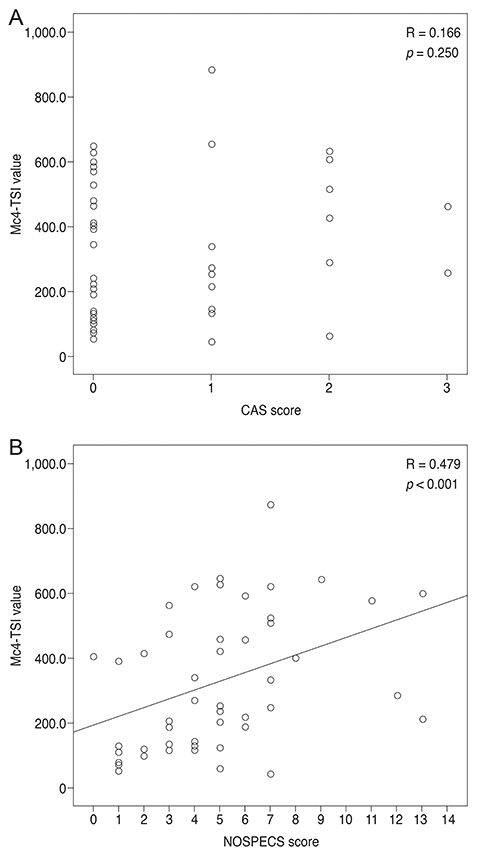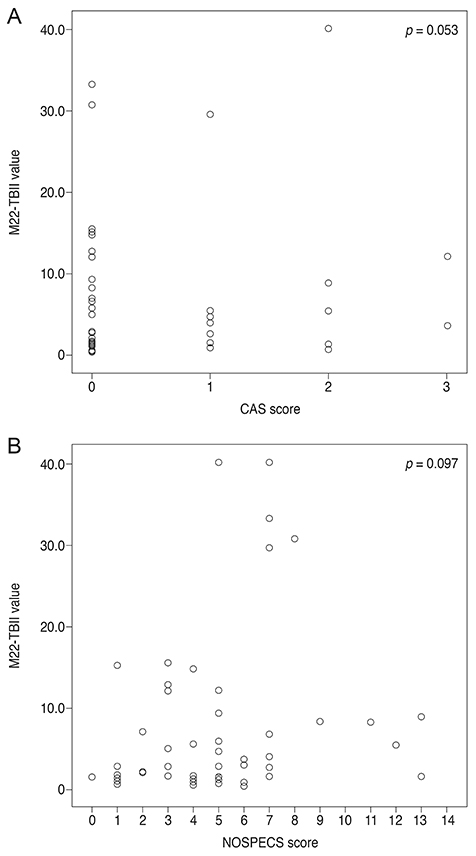Korean J Ophthalmol.
2015 Aug;29(4):213-219. 10.3341/kjo.2015.29.4.213.
Clinical Association of Thyroid Stimulating Hormone Receptor Antibody Levels with Disease Severity in the Chronic Inactive Stage of Graves' Orbitopathy
- Affiliations
-
- 1Institute of Vision Research, Department of Ophthalmology, Yonsei University College of Medicine, Seoul, Korea. yoonjs@yuhs.ac
- 2Department of Ophthalmology, Soonchunhyang University Bucheon Hospital, Soonchunhyang University College of Medicine, Bucheon, Korea.
- KMID: 2363764
- DOI: http://doi.org/10.3341/kjo.2015.29.4.213
Abstract
- PURPOSE
To investigate associations between serum thyroid stimulating hormone (TSH) receptor antibody (TRAb) levels and Graves' orbitopathy (GO) activity/severity in chronic-stage GO and compare the performance of two newly-developed TRAb assays (third-generation TSH-binding inhibition immunoglobulin [TBII] assay versus Mc4 thyroid-stimulating immunoglobulin [TSI] bioassay).
METHODS
This study is a retrospective review of medical charts and blood tests from Korean GO patients who first visited the departments of ophthalmology and endocrinology, Yonsei University College of Medicine from January 2008 to December 2011, were diagnosed with GO and Graves' hyperthyroidism, and were followed up for > or =18 months. Third-generation M22-TBII and Mc4-TSI assays were performed in the chronic-inactive GO patients in whom euthyroidism status was restored. Patients' GO activity/severity clinical activity scores (CAS), and modified NOSPECS scores were examined for a correlation with TRAb assays.
RESULTS
Fifty patients (mean age, 41.3 years; 41 females) were analyzed. The mean duration of Graves' hyperthyroidism symptom was 63 months (range, 18 to 401 months) and that of GO was 46 months (range, 18 to 240 months). All patients had been treated previously with anti-thyroid drugs for a median period of 52.3 months, and two patients underwent either radioiodine therapy or total thyroidectomy. Mean CAS and NOSPECS scores were 0.5 +/- 0.9 (standard deviation) and 4.8 +/- 3.1, respectively. Mean M22-TBII and Mc4-TSI values were 7.5 +/- 10.2 IL/L and 325.9 +/- 210.1 specimen-to-reference control ratio. TSI was significantly correlated with NOSPECS score (R = 0.479, p < 0.001); however, TBII was not associated with NOSPECS score (p = 0.097). Neither TSI nor TBII correlated with CAS (p > 0.05), because GO inflammatory activity subsided in the chronic stages of GO.
CONCLUSIONS
In chronic-inactive GO after euthyroid restoration, GO activity score did not associate with serum levels of TRAb or TBII. However, levels of the functional antibody Mc4-TSI did correlate with GO severity. Therefore, the TSI bioassay is a clinically relevant measure of disease severity even in chronic inactive GO.
Keyword
MeSH Terms
Figure
Reference
-
1. Bahn RS. Graves' ophthalmopathy. N Engl J Med. 2010; 362:726–738.2. Hales IB, Rundle FF. Ocular changes in Graves' disease: a long-term follow-up study. Q J Med. 1960; 29:113–126.3. Eckstein AK, Plicht M, Lax H, et al. Clinical results of anti-inflammatory therapy in Graves' ophthalmopathy and association with thyroidal autoantibodies. Clin Endocrinol (Oxf). 2004; 61:612–618.4. Sanders J, Evans M, Premawardhana LD, et al. Human monoclonal thyroid stimulating autoantibody. Lancet. 2003; 362:126–128.5. Sanders J, Jeffreys J, Depraetere H, et al. Characteristics of a human monoclonal autoantibody to the thyrotropin receptor: sequence structure and function. Thyroid. 2004; 14:560–570.6. Massart C, Sapin R, Gibassier J, et al. Intermethod variability in TSH-receptor antibody measurement: implication for the diagnosis of Graves disease and for the follow-up of Graves ophthalmopathy. Clin Chem. 2009; 55:183–186.7. Kamijo K, Ishikawa K, Tanaka M. Clinical evaluation of 3rd generation assay for thyrotropin receptor antibodies: the M22-biotin-based ELISA initiated by Smith. Endocr J. 2005; 52:525–529.8. Smith BR, Bolton J, Young S, et al. A new assay for thyrotropin receptor autoantibodies. Thyroid. 2004; 14:830–835.9. Gerding MN, van der Meer JW, Broenink M, et al. Association of thyrotrophin receptor antibodies with the clinical features of Graves' ophthalmopathy. Clin Endocrinol (Oxf). 2000; 52:267–271.10. Dragan LR, Seiff SR, Lee DC. Longitudinal correlation of thyroid-stimulating immunoglobulin with clinical activity of disease in thyroid-associated orbitopathy. Ophthal Plast Reconstr Surg. 2006; 22:13–19.11. Lytton SD, Kahaly GJ. Bioassays for TSH-receptor autoantibodies: an update. Autoimmun Rev. 2010; 10:116–122.12. Lytton SD, Ponto KA, Kanitz M, et al. A novel thyroid stimulating immunoglobulin bioassay is a functional indicator of activity and severity of Graves' orbitopathy. J Clin Endocrinol Metab. 2010; 95:2123–2131.13. Ponto KA, Kanitz M, Olivo PD, et al. Clinical relevance of thyroid-stimulating immunoglobulins in graves' ophthalmopathy. Ophthalmology. 2011; 118:2279–2285.14. Jang SY, Shin DY, Lee EJ, et al. Relevance of TSH-receptor antibody levels in predicting disease course in Graves' orbitopathy: comparison of the third-generation TBII assay and Mc4-TSI bioassay. Eye (Lond). 2013; 27:964–971.15. Finamor FE, Martins JR, Nakanami D, et al. Pentoxifylline (PTX): an alternative treatment in Graves' ophthalmopathy (inactive phase): assessment by a disease specific quality of life questionnaire and by exophthalmometry in a prospective randomized trial. Eur J Ophthalmol. 2004; 14:277–283.16. Khoo TK, Bahn RS. Pathogenesis of Graves' ophthalmopathy: the role of autoantibodies. Thyroid. 2007; 17:1013–1018.17. Mourits MP, Prummel MF, Wiersinga WM, Koornneef L. Clinical activity score as a guide in the management of patients with Graves' ophthalmopathy. Clin Endocrinol (Oxf). 1997; 47:9–14.18. Eckstein AK, Plicht M, Lax H, et al. Thyrotropin receptor autoantibodies are independent risk factors for Graves' ophthalmopathy and help to predict severity and outcome of the disease. J Clin Endocrinol Metab. 2006; 91:3464–3470.19. Eckstein AK, Lax H, Losch C, et al. Patients with severe Graves' ophthalmopathy have a higher risk of relapsing hyperthyroidism and are unlikely to remain in remission. Clin Endocrinol (Oxf). 2007; 67:607–612.20. Werner SC. Modification of the classification of the eye changes of Graves' disease. Am J Ophthalmol. 1977; 83:725–727.21. Laurberg P, Wallin G, Tallstedt L, et al. TSH-receptor autoimmunity in Graves' disease after therapy with anti-thyroid drugs, surgery, or radioiodine: a 5-year prospective randomized study. Eur J Endocrinol. 2008; 158:69–75.22. Jang SY, Shin DY, Lee EJ, Yoon JS. Clinical characteristics of Graves' orbitopathy in patients showing discrepancy between levels from TBII assays and TSI bioassay. Clin Endocrinol (Oxf). 2014; 80:591–597.23. Chng CL, Seah LL, Khoo DH. Ethnic differences in the clinical presentation of Graves' ophthalmopathy. Best Pract Res Clin Endocrinol Metab. 2012; 26:249–258.
- Full Text Links
- Actions
-
Cited
- CITED
-
- Close
- Share
- Similar articles
-
- Difference of Thyroid Stimulating Antidody Activities Measured in Chinese Hamster Ovary Cells Stably Transfected with Human TSH Receptor and in FRTL-5 Cells in Graves Disease and Its Clinical Correlations
- Clinical Implication of TSH Receptor Antibody Measurement
- Association Between Thyroid Associated Ophthalmopath and Thyroid Autoantibody
- Antithyroid drug therapy for Graves’ disease
- Treatment of relapsed hyperthyroidism



